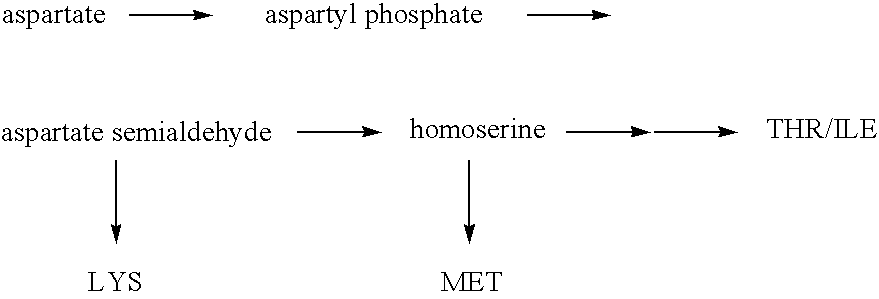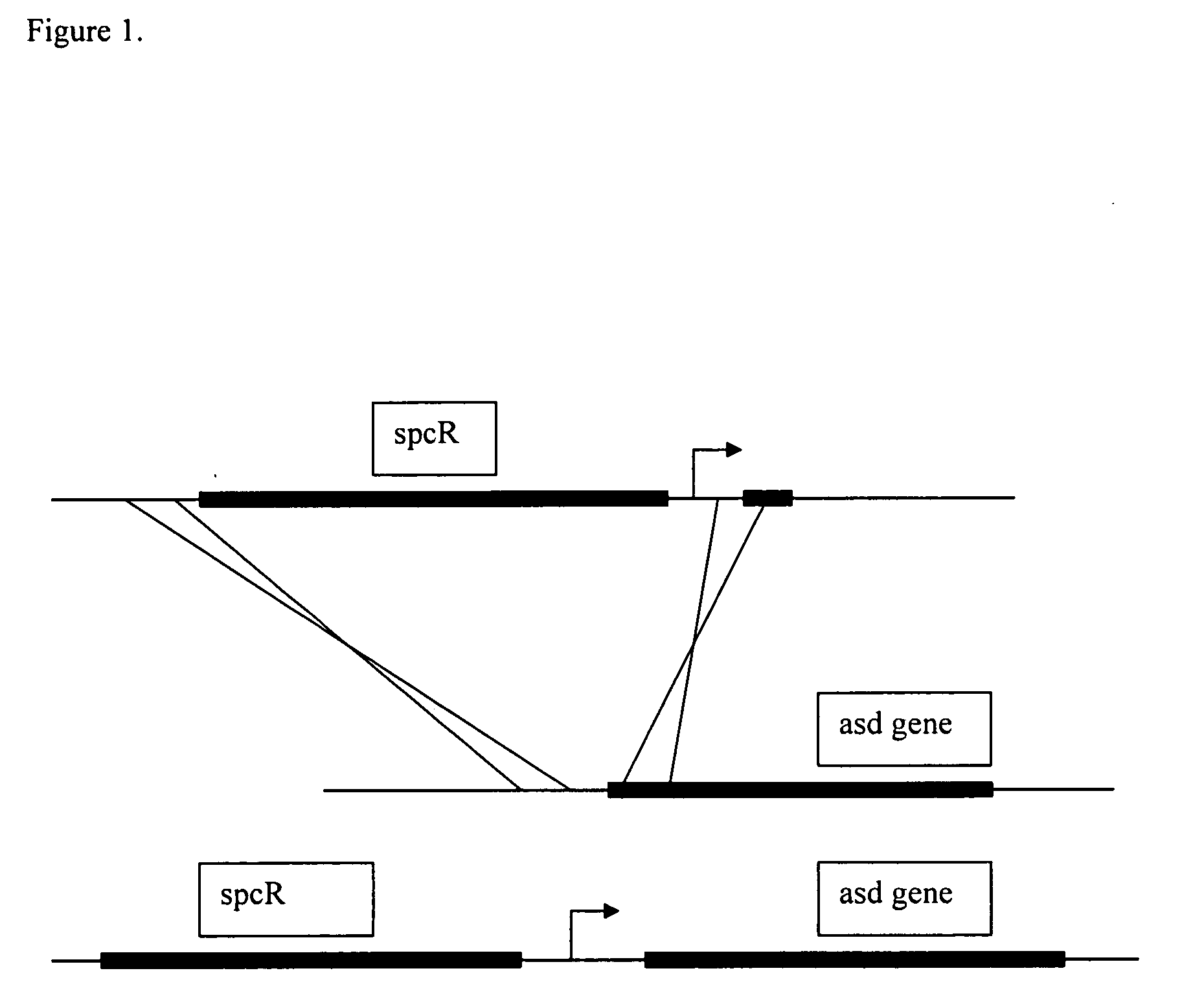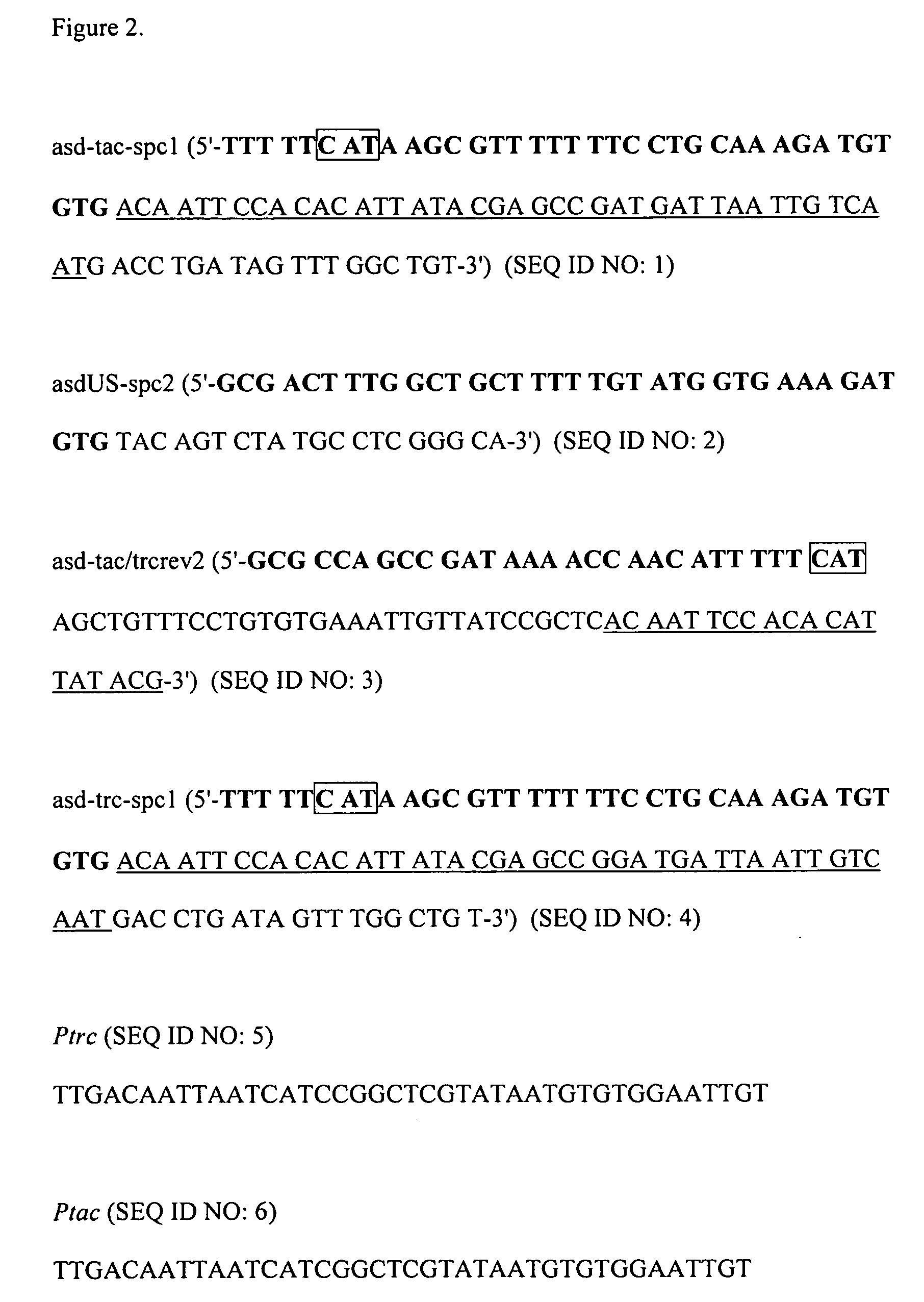Escherichia coli strains that over-produce L-threonine and processes for their production
a technology of l-threonine and strains, applied in the field of microorganism and microbial genetics, can solve the problems of reducing the steady-state level of intracellular l-threonine, and cells needing isoleucine, and achieve the effect of less sensitive to regulation
- Summary
- Abstract
- Description
- Claims
- Application Information
AI Technical Summary
Benefits of technology
Problems solved by technology
Method used
Image
Examples
example 1
[0127] Example 1 describes the production of strains with Ptac or Ptrc promoters inserted immediately upstream of the asd gene of Escherichia coli positioned in a manner that causes the constitutive high expression level of the asd gene product.
[0128] Ptac and Ptrc promoters (De Boer, et al, 1983; Brosius et al., 1985; and FIG. 3) were inserted upstream of the wild-type asd gene by transformation of strain TH25.79 with linear DNA encoding the streptomycin resistance gene from plasmid pBSL 175 (Alexeyev et al., 1995) (FIG. 1). Plasmid pBSL175 was used as template in a polymerase chain reaction (PCR) using primers asdUS-spc2 (SEQ ID NO: 2) (FIG. 2) and asd-tac-spc1 (SEQ ID NO: 1) (FIG. 2) (for insertion of the Ptac promoter) or asd-trc-spc1 (SEQ ID NO: 4) (FIG. 2) (for insertion of the Ptrc promoter). These PCR products contained the streptomycin resistance gene flanked by sequence homologous to that of the asd allele of strain TH25.79 and with the Ptac or Ptrc promoter substituted f...
example 2
[0132] Example 2 describes the production of strains with the constitutive high expression of the asd gene product controlled either by promoter Ptac and the lac ribosomal binding site from Escherichia coli or by Ptrc and the lac ribosomal binding site from Escherichia coli.
[0133] Substitution of the native asd ribosomal binding site (Haziza et al., 1982b) with the ribosomal binding site of the lac operon of Escherichia coli (Looman et al., 1985) was accomplished by transformation of linear DNA encoding the streptomycin resistance gene from plasmid pBSL175 (Alexeyev et al., 1995). The linear DNA was produced by PCR using primers asdUS-spc2 (SEQ ID NO: 2) (FIG. 2) and asd-tac / trcrev2 (SEQ ID NO: 3) (FIG. 2) with chromosomal DNA from strain s4397-117-1 (Table 1) or strain s4480-155-2 (Table 1) as template.
TABLE 1RibosomeStrainPromoterbinding sitePrimersTemplateS4397-117-1Ptacasdasd-tac-spc1 (SEQ ID NO:pBSL1751) & asdUS-spc2 (SEQ IDNO: 2)S4480-155-2Ptrcasdasd-trc-spc1 (SEQ ID NO:pBS...
example 3
[0139] Example 3 demonstrates the utility of placing Ptac or Ptrc promoters upstream of asd for causing high expression levels of the asd gene product.
[0140] To asses the expression levels of Asd achieved by placing asd under the control of either Ptac or Ptrc, mutant strains were grown in shake flasks and assayed for Asd specific activity. Strains TH25.79, s4397-117-1, s4480-155-2, s4480-182-1, and s4480-182-4 (strains listed in Table 1) were grown in 20 ml media SM2 (24.36 μl K2HPO4, 9.52 g / l KH2PO4, 15 g / l yeast extract, 5 g / l (NH4)2SO4, 32.5 g / l dextrose, 1.0 μl MgSO4.7H2O pH 7.2) overnight on a New Brunswick G53 shaker at 240 rpm at 37° C. The resultant biomass was assayed for Asd specific activity by following the L-aspartate β-semialdehyde dependent reduction of NADP+as previously described (Cremer et al., 1988). As shown in Table 2, Asd activity is increased greatly by the introduction of either a Ptac promoter or a Ptrc promoter in front of the asd gene. Under these growth...
PUM
| Property | Measurement | Unit |
|---|---|---|
| pH | aaaaa | aaaaa |
| pH | aaaaa | aaaaa |
| pH | aaaaa | aaaaa |
Abstract
Description
Claims
Application Information
 Login to View More
Login to View More - R&D
- Intellectual Property
- Life Sciences
- Materials
- Tech Scout
- Unparalleled Data Quality
- Higher Quality Content
- 60% Fewer Hallucinations
Browse by: Latest US Patents, China's latest patents, Technical Efficacy Thesaurus, Application Domain, Technology Topic, Popular Technical Reports.
© 2025 PatSnap. All rights reserved.Legal|Privacy policy|Modern Slavery Act Transparency Statement|Sitemap|About US| Contact US: help@patsnap.com



